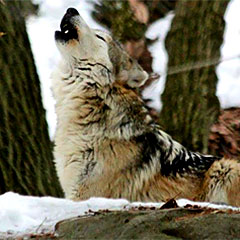Since 1998, Zoo New England has been committed to re-introducing Mexican gray wolves into the wilds of the American Southwest, where they once lived in large numbers. Stone Zoo is one of about 51 facilities across the country and in Mexico participating in the Mexican Wolf Survival Plan (SSP). We've overseen births of these rare animals at Stone Zoo and collaborated closely with other facilities to transfer and receive wolves on their journey to being re-introduced to the wild.
Zoo New England participates in the SAFE Mexican Wolf initiative, a cross-border recovery program aimed at fostering collaboration with local communities in the recovery regions of Mexico and the United States. Through partnerships with the U.S. Fish and Wildlife Service, AZA-accredited institutions, and other stakeholders, SAFE Mexican Wolf actively promotes conservation endeavors for the preservation of this species.
The Mexican gray wolf (Canis lupus baileyi), also known as “el lobo” in Spanish, was once common throughout western Texas, southern New Mexico, central Arizona and northern Mexico. But by the mid-1900s they were eliminated from the wild in the U.S., victims of eradication efforts to prevent them from preying on livestock. They survived here only in small captive populations, and in Mexico their population also dwindled dramatically.
Great strides have been made to grow the Mexican gray wolf population and reintroduce them into the wild. In 1976, they were listed as endangered under the Endangered Species Act. The Mexican wolf recovery team was formed and a conservation and survival plan was established in 1979.
Back from the brink...slowly
Nearly extinct by the mid-1900s, the wild Mexican Gray Wolf population is slowly coming back from the brink of extinction through the work of the Mexican Wolf SSP and other organizations.
Institutions currently participating in the SSP (including Stone Zoo) house approximately 350 wolves. The SSP’s goal is to maintain at least 240 animals in captivity at all times to ensure the security of the species, while still being able to breed animals for reintroduction.
For the first time since reintroduction into the wild, the population of Mexican wolves in Arizona and New Mexico has surpassed 200. Recent counts by the U.S. Fish and Wildlife Service documented a minimum of 241 wild Mexican wolves in 2022 -- a 23 percent increase from the previous year. This marks the seventh consecutive year of growth in the wild population.
Over half of the wild Mexican wolf population is now monitored through radio collars using satellite technology to record their location. Wildlife biologists use this information to gain timely information about wolf behavior in the wild and assist with management of the wild population.
While this growth is encouraging, re-establishing the Mexican gray wolf population continues to be a slow and complex process, and Zoo New England is unwavering in its commitment to the future of this rarest of wolves.
Here at Stone Zoo, we have six Mexican gray wolf brothers. The wolves, who were named in honor of female conservationists, are named Craighead, Mittermeier, Lek, Carson, Goodall and Beattie.
As they stalk the hills of their expansive wooded habitat, these animals are never far from one another, owing to their tight pack behavior. Want to know which wolf is the “Alpha,” or dominant animal, that day? Look for the wolf whose tail is sticking straight up in the air. The one with its tail tucked between its legs is the most subordinate animal. In addition to the howls that echo through the habitat, visitors might hear other vocalizations, such as the whimpering of subordinate wolves as the dominant wolf passes by them.
- Donate to Zoo New England to help sustain our Mexican gray wolf conservation work.
- Zoodopt a Mexican gray wolf! Zoodoption helps us provide excellent food, care and enrichment for all of our animals.
- Help spread a positive opinion on wolves, as many decisions made are based in fear for children or livestock, and supporting education and initiatives for livestock rotation techniques, which protect farm animals and limits damage done to wolf habitat.






